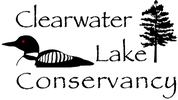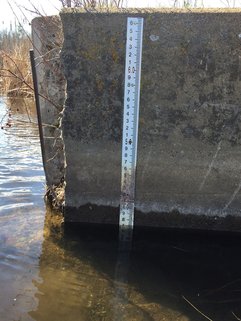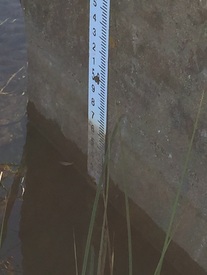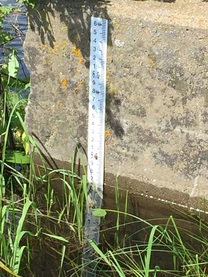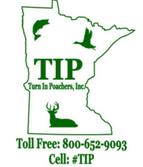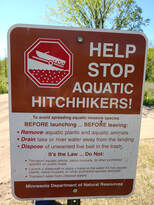|
Beaver - 2018
We started out this year without a Beaver trapper. After determining that our previous trapper had retired, the lake association hired Derek Nord to trap this summer.
Derek is a licensed trapper and has all the proper permits from the DNR to trap beaver in the the Nokasippi and the Clearwater Forest Aquatic Management for the purpose of water level management. He spent time walking the Nokasippi watershed and evaluating the scope of our problem. This helped him to understand our beaver structure and determine the best approach resolving it. He uses 2 types of traps, Conabear and leg traps. Please be aware that the traps are private property and distributing or interfering with a trap is illegal and can be dangerous. The traps are installed on Friday night and removed on Sunday. It is a law that a trapper check and clear his traps every 24 hours for humane purposes. The primary trapping is around the beaver dams. Although it is much appreciated, any volunteers that are pulling the beaver dams down should do so between Monday and Wednesday. This will allow the beavers time to rebuild and have the traps installed on by Friday. Derek has been breaking up the beaver dams on Sunday when he pulls his traps for the week. |
UPDATE 10/25/18:

Derek Nord pulled a total of 7 beaver out of the Nokasippi watershed this summer and fall! That is an all time record since Clearwater Lake has hired trappers. The last walk through showed no new dams. We think we may have them all.
However, nature is resilient. Beaver in the surrounding areas will be having babies this winter and the this years babies, now juveniles will be looking for new homes next spring to start their own families. We will likely have a new set of neighbors move in next year.
However, nature is resilient. Beaver in the surrounding areas will be having babies this winter and the this years babies, now juveniles will be looking for new homes next spring to start their own families. We will likely have a new set of neighbors move in next year.
Bogs - 2018
Bogs are not new, however they have been particularly bad this year. The bog beds are damaged by people driving over the bogs near the boat launch in the winter. The damage causes pieces to break away from the shore and float down stream. Of course what is down stream are the culverts that then become blocked.
Some of these bogs have been removed, other are too large and have been pulled to the sides of the stream and staked down. Still others are so large the only way to work with them is to cut them into pieces.
The staked pieces eventually break away and become problems again. Unfortunately, these bogs are VERY heavy and hard to work with.
The Clearwater Lake Association Board requested a permit to have a professional remove some of the larger pieces. However, the approval process became to expensive and we are back to managing it by hand.
Some of these bogs have been removed, other are too large and have been pulled to the sides of the stream and staked down. Still others are so large the only way to work with them is to cut them into pieces.
The staked pieces eventually break away and become problems again. Unfortunately, these bogs are VERY heavy and hard to work with.
The Clearwater Lake Association Board requested a permit to have a professional remove some of the larger pieces. However, the approval process became to expensive and we are back to managing it by hand.
Spring 2017 Report
|
Clearwater Lake is the headwaters of the Nokasippi River. The water that leaves the north end of the lake ends up in the Gulf of Mexico. Clearwater has no inflow but is fed by ground water springs. Clearwater can be considered a reservoir because of the dam on the north end which does hold the lake above its natural height. The Lake Association does not control the lake elevation but does work to maintain the outflow of the Nokasippi. As can be seem on the photos of the lake elevation scales mounted the dam, we have had a 12+ inch variation in the past 12 months.
The high water last summer did cause a lot of erosion and shoreline damage. You will see a number of pine tree tip overs along the Clearwater Forest shoreline. The high water loosens the root mass and makes them unstable and subject to winds. Also high water over the winter can result in ice heave damage. The lake association is looking to set up a volunteer committee who want to help in our out flow efforts. This entails cleaning the grate on the culvert which passes under Hwy 8 and deconstruction beaver dams in the river. The culvert requires cleaning every week through the winter, and on an as needed basis in the summer. During the current low water phase all homeowners are encouraged to plant shoreline stabilization vegetation. The DNR has a lot of information on plants and the process. Fall 2016 Report
2016 will go into the record books as one of the top 3-wettest years ever, the impact of that has been felt on Clearwater. 2016 set a new all-time high for lake elevation and we maintained that for nearly 6-weeks. (That’s not a good record to have.)
With no inlets our water level is controlled by 2 factors, rainfall/run off and the static charge of the ground water feeding the springs that feed Clearwater. The impact of the rainfall-runoff is immediate but the static load can take weeks to manifest, that’s why we have had such a struggle this summer to get the lake level in control. In a perfect world the lake should be able to manage itself, but the 1950’s act to turn Clearwater into a reservoir present a new set of challenges as does the exploding beaver population. Great efforts were extended by a group of volunteers to keep the water flowing between the dam and Hwy 8 culvert with a lot of grate cleaning and beaver dam busing done by Helen Bergen. In addition Helen is working with a trapper to help reduce the beaver activity in the river. Why is water height important? High water increases shoreline erosion. Erosion brings nutrients into the Lake. Added nutrients increase algae growth. Increased algae, reduces visibility cutting off oxygen to certain fish species. Dead fish stink. A high water elevation at freeze up causes massive ice heave damage in the spring. Go forward plan. The Board has an ongoing conversation with the DNR regarding the water flow between the Hwy 8 culvert and Eagle Lake (the next lake downstream). We believe that Clearwater being the headwater of the Nokassippi River and an important part of the upper Mississippi water shed should rate a higher level on attention. An interesting fact is Clearwater is 21 feet higher than Eagle so we should expect a steady outflow. The benchmark for the low point of lake elevation is established by the dam. There will always be seasonal ups and downs dependent on rain and snow but we should work to maintain a clear path for the outflow of the Nokassippi river. Ideally we would like a low water level going into the winter freeze to prevent extensive ice heave damage. |
Water Levels are measured on the dam at the public landing. The scale is in feet and 10th of a foot.
Photos by Jeff Zernov
|
